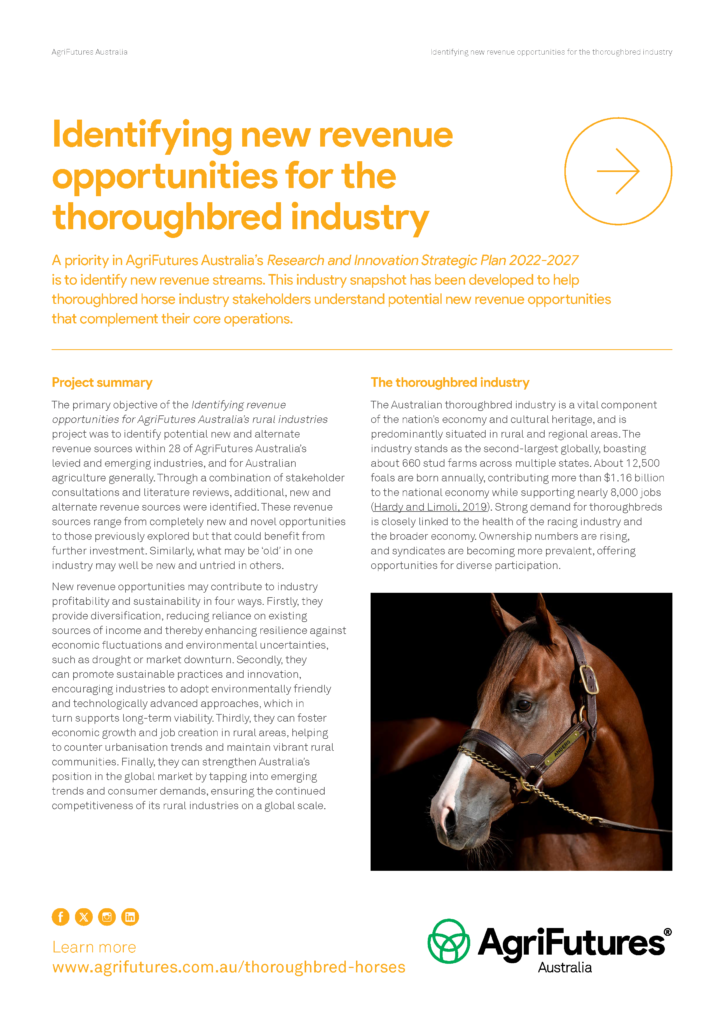Project overview: A strategy to increase demand for retired Thoroughbreds in Australia
The Thoroughbred industry in Australia is the second largest in the world, both in terms of breeding and the number of races held. The industry...
 THOROUGHBRED HORSES
THOROUGHBRED HORSES 
2 pages
Published: 11 Oct 2024
Author(s): AgriFutures Australia
Download report PDF
DownloadThe primary objective of the Identifying revenue opportunities for AgriFutures Australia’s rural industries project was to identify potential new and alternate revenue sources within 28 of AgriFutures Australia’s levied and emerging industries, and for Australian agriculture generally. Through a combination of stakeholder consultations and literature reviews, additional, new and alternate revenue sources were identified. These revenue sources range from completely new and novel opportunities to those previously explored but that could benefit from further investment. Similarly, what may be ‘old’ in one industry may well be new and untried in others.
New revenue opportunities may contribute to industry profitability and sustainability in four ways. Firstly, they provide diversification, reducing reliance on existing sources of income and thereby enhancing resilience against economic fluctuations and environmental uncertainties, such as drought or market downturn. Secondly, they can promote sustainable practices and innovation, encouraging industries to adopt environmentally friendly and technologically advanced approaches, which in turn supports long-term viability. Thirdly, they can foster economic growth and job creation in rural areas, helping to counter urbanisation trends and maintain vibrant rural communities. Finally, they can strengthen Australia’s position in the global market by tapping into emerging trends and consumer demands, ensuring the continued competitiveness of its rural industries on a global scale.
Industry-specific challenges
Specific insights relating to the Australian thoroughbred industry include:
1. Ongoing improvement in the welfare of thoroughbred horses through all stages of life is a high priority. In recent years, there has been rising public interest and expectations around sustainability and social licence, and continuing to address these concerns will be vital for the long-term sustainability of the industry.
2. For every mare covered, a healthy, saleable yearling is achieved 65% of the time. This rate has only slightly improved in past decades, reflecting the complexity of managing factors that contribute to fertility in the thoroughbred. Ongoing research to increase this rate and ensure optimal welfare outcomes remains a high priority for industry.
3. Employee shortages across a range of skills need to be addressed to ensure there is a stable, productive and motivated workforce.
4. Diseases and parasites have potentially severe adverse impacts on the health, productivity and welfare of thoroughbred horses. Antimicrobial resistance is an issue that requires careful stewardship by the industry.
Industry-specific opportunities
Specific opportunities relating to the Australian thoroughbred industry include:
1. ‘Tourism and experience hubs’ in key breeding regions, inspired by international models like Horse Country in Kentucky, USA and Thoroughbred Country in Ireland, can attract visitors and stimulate economic growth while promoting horse welfare and community engagement. Activities could include guided tours of stud farms, educational programs on horse breeding and care, interactive experiences like horse riding and equine therapy, and museum and exhibition spaces showcasing the industry’s history.
2. Innovations in veterinary equipment and technologies, such as mobile diagnostics, rehabilitation tools, monitoring systems and telemedicine, can improve breeding outcomes, horse health and operational efficiency. Collaboration between stakeholders is key to addressing industry-specific challenges.
3. Genetic consulting and advisory services can assist with disease management and improve breeding outcomes. Services could include genetic screening for hereditary diseases, identifying genetic markers for desirable traits, and genomic sequencing, which offer niche revenue opportunities for breeders.